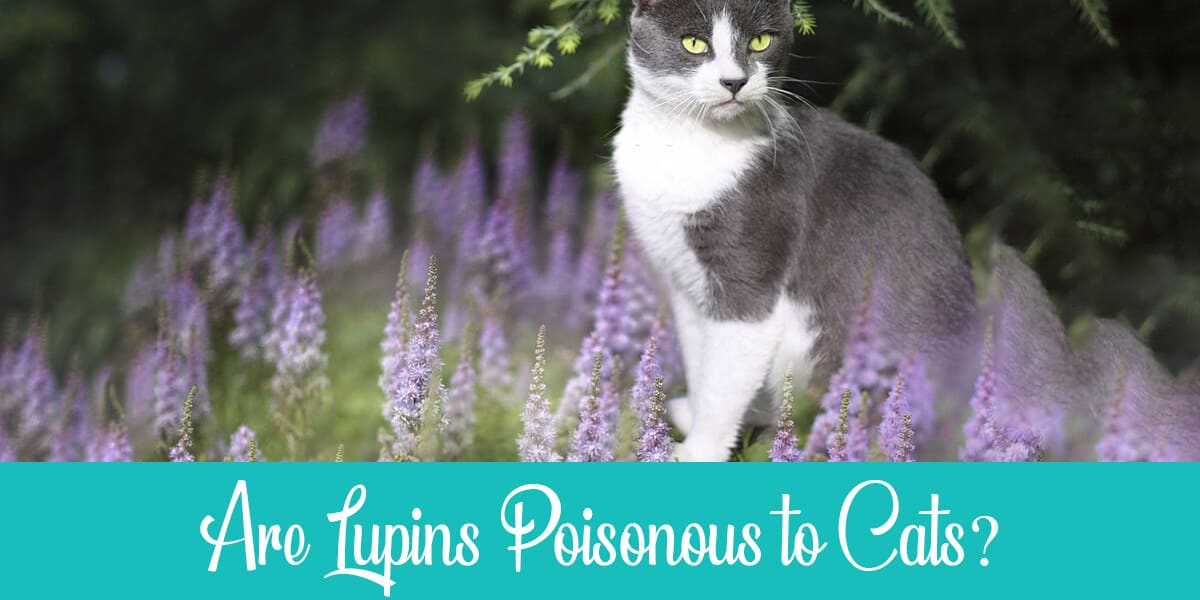The irresistible beauty of a Lupin’s foliage and the inquisitive nature of cats raise an important question: are lupins poisonous to cats? After all, lupins have some of the most vividly colorful flowers in any perennial houseplant.
In this article, we’ll be answering all your questions regarding lupin poisoning. We’ll cover the symptoms of lupin poisoning, what to do if you suspect your cat has been poisoned, and how you can prevent your cat from getting poisoned by a lupin.
Let’s get started!
Table of Contents
Are Lupins Poisonous or toxic to Cats?
The poisonous effects of lupins aren’t well-established, even on the ASPCA. That said, lupins are regarded as moderately poisonous to cats. If ingested in large quantities, lupin poisoning can produce potentially life-threatening effects. Some of the more common effects include excess salivation, vomiting, diarrhea, and difficulty breathing.
In extreme cases, it can lead to respiratory depression, loss of consciousness, or even death.
Effects of Lupin Poisoning on Cats
Most symptoms are mild to moderate when it comes to lupin poisoning, and fatal incidents are extremely rare. Nonetheless, it’s important to look out for symptoms that require emergency veterinarian intervention.
Here are some of the most common adverse effects of lupin poisoning:
Excess Salivation
Perhaps the first telltale sign your cat has been poisoned is excess salivation. This is usually accompanied by mouth irritation or frequent pawing at the mouth.
If your cat doesn’t display any other symptoms, this is usually not a sign of concern. You shouldn’t take your cat to the vet unless you notice your cat has difficulty eating or stops eating altogether.
Excess salivation alone usually resolves the next day. If the problem persists or worsens in the upcoming days, let your vet know.
Gastric Disturbances
Cats that display signs of mouth irritation almost always start experiencing gastric upsets. The effects can range from mild to moderate to severe, depending on the amount of poisonous plant ingested.
Gastric disturbances include abdominal pain, flatulence, and bloating. You may notice some bloating without any signs of distress, which is a good indicator the adverse effects are mild.
However, if your cat starts growling from the pain, stops eating, or becomes noticeably agitated, let your vet know immediately.
GIT disturbances without diarrhea and/or vomiting usually resolve quickly and without medical intervention.
Related Posts:
– The Truth Behind Kalanchoe Toxicity to Cats
– Is Dracaena Harmful to Cats?
– Are Daffodils Poisonous to Cats?
– Are Marigolds Toxic to Cats?
Diarrhea
Diarrhea is a common symptom of lupin poisoning, but it can greatly vary in severity. Again, this depends on the amount of poisonous plant ingested and how your cat’s body is handling the situation.
Some loose stool is not a serious cause of concern. However, prolonged diarrhea can cause your cat to become dehydrated, lethargic, and stressed out.
Make sure to inform your vet if diarrhea persists or worsens over the next few days. Usually, diarrhea doesn’t exceed a couple of days after ingesting the poisonous plant.
Nausea and Vomiting
If you suspect your cat has been poisoned by lupin, your vet may ask you to induce vomiting by giving it a solution of hydrogen peroxide (from one to three teaspoons, depending on your cat’s weight)
Don’t confuse this with vomiting from lupin poisoning, which can begin as soon as a couple of hours after ingestion. You may notice your cat start to gag and vomit if the gastric irritation is too unbearable.
If your cat vomits easily from fur balls or another underlying medical condition, it’ll be more likely to vomit from lupin poisoning.
If your cat vomits more than twice in the span of two hours, take your cat to the vet immediately. Otherwise, let your vet know about the frequency of vomiting and the symptoms accompanying it.
If you notice blood in the vomit, this is an indication of serious gastrointestinal injury. Take your cat to the vet as soon as possible for emergency care.
Related:
– Is lisianthus toxic to cats?
– Are Freesias poisonous to cats?
Difficulty Breathing
Labored breathing isn’t as common as the other symptoms. However, larger amounts of lupin may cause your cat to pant, have trouble breathing, or stop breathing entirely in extreme cases.
Inform your vet as soon as you notice any respiratory symptoms. If your cat stops breathing, call the Animal Poison Center hotline immediately and follow instructions to perform CPR.
Again, this is a rare adverse effect associated with large doses of lupin. In the case of any respiratory distress, the quicker you act, the more likely you can save your cat’s life.
What to Do if Your Cat Is Poisoned
All symptoms of lupin poisoning can be treated at home and usually resolve on their own. The only thing that would require a visit to the vet is if your cat has difficulty breathing or shows any signs of general distress.
If you suspect your cat has been poisoned in the last couple of hours, your vet may ask you to induce vomiting using a hydrogen peroxide solution. You should never induce vomiting without your vet’s supervision, and never induce vomiting on an unconscious cat.
Your vet may also advise you to provide plenty of fluids for your cat and keep it under observation. If your cat starts showing signs of swelling, especially at the mouth area, your vet may prescribe an antihistamine agent to reduce the inflammation.
Preventive Measures to Avoid Lupin Poisoning
Cats are smart animals. If your cat gets poisoned by lupins once, it’s highly likely to associate the adverse effects with the plant at hand.
However, if you notice your cat is still intrigued by the colorful foliage, either remove the plants from its vicinity or restrict your cat’s access from the garden area.
A lot of pet owners recommend sprinkling pepper around the plant or spraying citric acid. While this is usually effective at repelling the cats, it’s not guaranteed to deter them. The best practice would be to create a barrier between your pets and the poisonous plants.
In Conclusion
It’s a common misconception that lupins aren’t poisonous to cats. However, the alkaloids in the flowers and leaves are, indeed, poisonous.
If your cat ingests parts of the plant, it’s crucial to keep your cat under continuous observation. If your cat starts showing signs of distress, take it to the vet immediately.

I’ve been living with cats since 2008 and I can confidently say I have more feline friends than humans lol. I currently live with 5 cats in different life stages; two of them are less than one year old, one is 2-ish years old and the oldest two are 9-ish years old. I’ve developed a strong bond with cats over the years and I’m eager to share my experience through this blog. You can learn more about my cats here.

